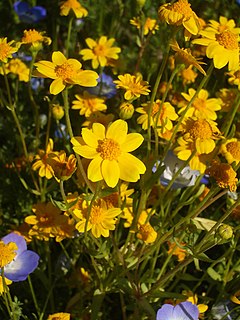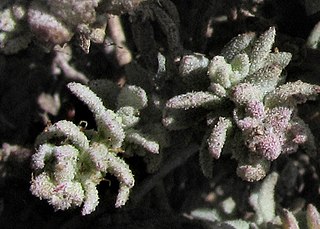
Eschscholzia californica, the California poppy, golden poppy, California sunlight or cup of gold, is a species of flowering plant in the family Papaveraceae, native to the United States and Mexico. It is cultivated as an ornamental plant flowering in summer, with showy cup-shaped flowers in brilliant shades of red, orange and yellow. It is also used as food or a garnish. It became the official state flower of California in 1903.

The turkey is a large bird in the genus Meleagris, native to North America. There are two extant turkey species: the wild turkey of eastern and central North America and the ocellated turkey of the Yucatán Peninsula in Mexico. Males of both turkey species have a distinctive fleshy wattle, called a snood, that hangs from the top of the beak. They are among the largest birds in their ranges. As with many large ground-feeding birds, the male is bigger and much more colorful than the female.

Carpenteria californica, the tree anemone or bush anemone, is a species of flowering plant in the hydrangea family Hydrangeaceae. It is the sole species in the monotypic genus Carpenteria, which is closely related to the similar genus Philadelphus. It is a flowering evergreen shrub native to the Sierra Nevada foothills in California.

Umbellularia californica is a large hardwood tree native to coastal forests and the Sierra foothills of California, as well as to coastal forests extending into Oregon. It is endemic to the California Floristic Province. It is the sole species in the genus Umbellularia.

Darlingtonia californica, also called the California pitcher plant, cobra lily, or cobra plant, is a species of carnivorous plant. As a pitcher plant it is the sole member of the genus Darlingtonia in the family Sarraceniaceae. It is native to Northern California and Oregon growing in bogs and seeps with cold running water. This plant is designated as uncommon due to its rarity in the field.

The California scrub jay is a species of scrub jay native to western North America. It ranges from southern British Columbia throughout California and western Nevada near Reno to west of the Sierra Nevada. The California scrub jay was once lumped with Woodhouse's scrub jay and collectively called the western scrub jay. The group was also lumped with the island scrub jay and the Florida scrub jay; the taxon was then called simply scrub jay. The California scrub jay is nonmigratory and can be found in urban areas, where it can become tame and will come to bird feeders. While many refer to scrub jays as "blue jays", the blue jay is a different species of bird entirely.

Valeriana is a genus of flowering plants in the family Caprifoliaceae, members of which may by commonly known as valerians. It contains many species, including the garden valerian, Valeriana officinalis. Some species are native to Europe, others to North America and South America.

Juniperus californica, the California juniper, is a species of juniper native to southwestern North America.

Adelpha californica, the California sister, is a species of butterfly in the family Nymphalidae. They are common in California, but can also be found in western Nevada and Oregon, as well as in northern Baja California. The upper surfaces of their wings are dark brown to black with wide cream white bands dissecting both wings and two orange patches near the tips of the forewings. The underside is variously colored with browns, blue, orange, and white. A. californica is unpalatable to predators and is part of a large mimicry complex.

Lasthenia, commonly known as goldfields, is a genus of the botanical family Asteraceae. The genus is named after Lasthenia of Mantinea, a cross-dressing female pupil of the ancient Greek philosopher Plato.

Juglans californica, the California black walnut, also called the California walnut, or the Southern California black walnut, is a large shrub or small tree of the walnut family, Juglandaceae, endemic to California.

Meleagridinae is a North American subfamily of birds in the family Phasianidae. It includes turkeys and their extinct relatives.

Dithyrea (shieldpod) is a small genus of flowering plants in the family Brassicaceae containing only one or two species. The California shieldpod or spectacle-pod, Dithyrea californica, is an abundant and unique-looking herb native to the southwestern United States and northern Mexico. The beach shieldpod, Dithyrea maritima, a rare plant found only on the coast of California and Baja California, is sometimes considered a subspecies of D. californica.

Trixis californica , the American threefold or American trixis, is a species of flowering plant in the family Asteraceae. It is native to the southwestern United States in California, Arizona, New Mexico, and Texas, and in Mexico in the states of Baja California, Chihuahua, Coahuila, Durango, Nuevo León, Sinaloa, Sonora, Tamaulipas, and Zacatecas.

The Californian turkey is an extinct species of turkey indigenous to the Pleistocene and early Holocene of California. It has been estimated that the Californian turkey went extinct about 10,000 years ago.
Iais is a genus of isopod crustaceans. Iais species are found in association with larger isopods of the family Sphaeromatidae, usually on the ventral surface of the larger animal, between the pereiopods and on the pleopods. They are native to Australasia and South America, although Iais californica and its host Sphaeroma quoyanum have invaded California, and I. californica was first described from Sausalito, California. Nine species are recognised:

Laytonia is an extinct genus of prehistoric halosaur that lived in deep water off the North American Pacific Coast from the Zemorrian Epoch until during the Upper Miocene subepoch, when tectonic uplift effectively destroyed the genus' habitat by making the deep water too shallow.
A. californica may refer to:

Extriplex is a plant genus in the subfamily Chenopodioideae of the family Amaranthaceae. It has been described in 2010 and comprises two species, that were formerly included in genus Atriplex. They are restricted to the California Floristic Province.
Alphaabyssovirus is a genus of positive-strand RNA viruses in the order Nidovirales which infect sea hares. The genus is monotypic. It contains only the subgenus Aplyccavirus, which contains only one species, Aplysia abyssovirus 1. Alphaabyssovirus is also the only member of the subfamily Tiamatvirinae, which in turn is the only member of family Abyssoviridae, which likewise is the only member of the Abnidovirineae suborder. Aplysia abyssovirus 1 was first isolated from a sample from a California sea hare.















